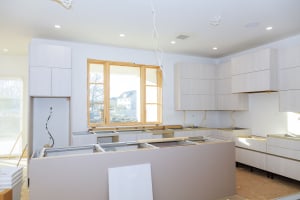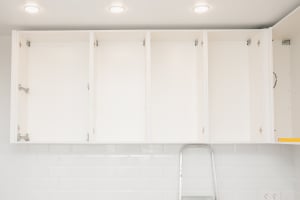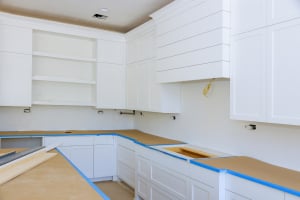
Upgrading your kitchen cabinets is a great way to increase the functionality, beauty, and overall value of your home. But before you get about remodeling your kitchen, it’s important to know how tall kitchen cabinets are. Let’s find out!
What Is the Standard Kitchen Cabinet Height?
The generally accepted standard measurement for kitchen cabinet height is thirty-six inches. This is a conventional base cabinet height that manufacturers use since it is convenient for most people.
When it comes to hanging cabinets above a kitchen counter, the rules are slightly different. Exact measurements vary depending on the cabinet style, your kitchen size, and the people who will utilize the space.
However, it is standard to install wall cabinets about eighteen inches above a countertop. This height is a good starting point, and it will give you enough space to comfortably fit appliances or supplies on the counter beneath the cabinets.
If you’d like a little more space, hanging the cabinets a bit higher is always an option. For example, large kitchens with high ceilings often call for higher wall cabinets (around twenty to twenty-two inches) to balance out the kitchen design.
We won’t recommend installing them higher than twenty-two inches, however, as the cabinetry may become unreachable, inconvenient for storage, and harder to clean.
What Is the Standard Kitchen Cabinet Depth?
The standard depth for kitchen wall cabinets is twelve inches. You can also find kitchen wall cabinets with a depth of fifteen to eighteen inches, typically installed above a microwave oven. Even deeper cabinets (up to twenty-four inches) can be installed over the refrigerator or other larger appliances.
The maximum depth for kitchen wall cabinets is twenty-four inches, as they cannot exceed the depth of the base cabinets. These cabinets require either a wall on one side to be mounted or a thick refrigerator panel to support their weight safely.
What Is the Standard Kitchen Cabinet Width?
Kitchen cabinet widths range from nine to forty-eight inches in three-inch increments.
A twelve-inch narrow cabinet can fit into otherwise unusable spaces and is handy for additional storage. On the other hand, a twenty-four-inch-wide kitchen cabinet is a standard size that works well for most kitchens. Finally, a thirty-six-inch-wide cabinet is ideal for larger kitchens that require extra storage.
How Tall Are Floor-To-Ceiling Cabinets?
Floor-to-ceiling cabinets typically come in three standard heights: eighty-four inches, ninety inches, and ninety-six inches. In a kitchen with eight-foot high ceilings, a ninety-six-inch cabinet will run from floor to the ceiling, while an eighty-four-inch cabinet will align uniformly with surrounding wall cabinetry.
If you aren’t sure which height to pick, the cabinetry style you’ve chosen can help determine whether you should extend it entirely from floor to ceiling or leave a little breathing room up top. Contemporary cabinets with a sleek design typically look best when completely filling out the wall space, while a less-than-full-height cabinet better suits a more traditional kitchen design.
You can also match the cabinet height with any upper cabinetry or neighboring cupboards your kitchen already has. If there are none, align your floor-to-ceiling cabinet with an architectural element of your kitchen, such as an arch or a doorway.
How to Find the Perfect Fit for Your Kitchen
To find the best kitchen cabinet height for your kitchen, stand upright in front of your cabinet space, bend your arms at ninety degrees, and then lower them about four or five inches. This should be a good enough height for your work surface, and you want to place your cabinets such that they leave enough room above your countertops.
However, it’s important to never rely on approximations when it comes to cabinetry. Make use of painter’s tape to map out your cabinet plan so you can accurately visualize the proportions and see how they work with your kitchen design.
When in doubt, it’s always recommended to stick with thirty-six inches (or eighteen inches above a countertop in case of hanging cabinets) as a standard height. This works for most kitchen designs and families with differently-sized people and is a safe choice if you plan on reselling or renting out your space in the future.













